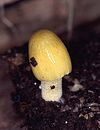
Chemoorganoheterotrophy
Encyclopedia

Organism
In biology, an organism is any contiguous living system . In at least some form, all organisms are capable of response to stimuli, reproduction, growth and development, and maintenance of homoeostasis as a stable whole.An organism may either be unicellular or, as in the case of humans, comprise...
is one that requires organic substrates
Substrate (biochemistry)
In biochemistry, a substrate is a molecule upon which an enzyme acts. Enzymes catalyze chemical reactions involving the substrate. In the case of a single substrate, the substrate binds with the enzyme active site, and an enzyme-substrate complex is formed. The substrate is transformed into one or...
to get its carbon
Carbon
Carbon is the chemical element with symbol C and atomic number 6. As a member of group 14 on the periodic table, it is nonmetallic and tetravalent—making four electrons available to form covalent chemical bonds...
for growth and development, and that produces its energy
Energy
In physics, energy is an indirectly observed quantity. It is often understood as the ability a physical system has to do work on other physical systems...
from oxido-reduction
Redox
Redox reactions describe all chemical reactions in which atoms have their oxidation state changed....
of an organic compound. This group of organisms may be further subdivided according to what kind of organic substrate and compound they use. Decomposers are examples of Chemoorganoheterotrophs which obtain carbon and electron reactions from dead organic matter. Herbivores and carnivores are examples of organisms that obtain carbon and electron reactions from living organic matter.

